Research Proposal: Student Mobility and Cultural Adjustment Analysis
VerifiedAdded on 2020/04/15
|23
|5323
|37
Report
AI Summary
This research proposal examines the increasing trend of international student mobility, driven by globalization and the pursuit of higher education. It investigates the factors influencing students' decisions to study abroad, with a particular focus on Asian students. The study explores the cultural adjustments and challenges, including culture shock, that international students face in new environments. The proposal outlines the research objectives, questions, and methodology, including data collection, sampling, and ethical considerations. It aims to identify the causes of the issue, its extent, and potential solutions to facilitate a smoother adaptation process for students. The research also considers the impact of globalization, economic factors, and the evolving demands of the job market on international student trends, as well as the existing gaps in the literature and the significance of addressing cultural adjustments. The proposal includes a timeline, resource requirements, and anticipated problems to be addressed. The research seeks to understand the dynamics of international student mobility, the challenges encountered, and strategies to mitigate these challenges.
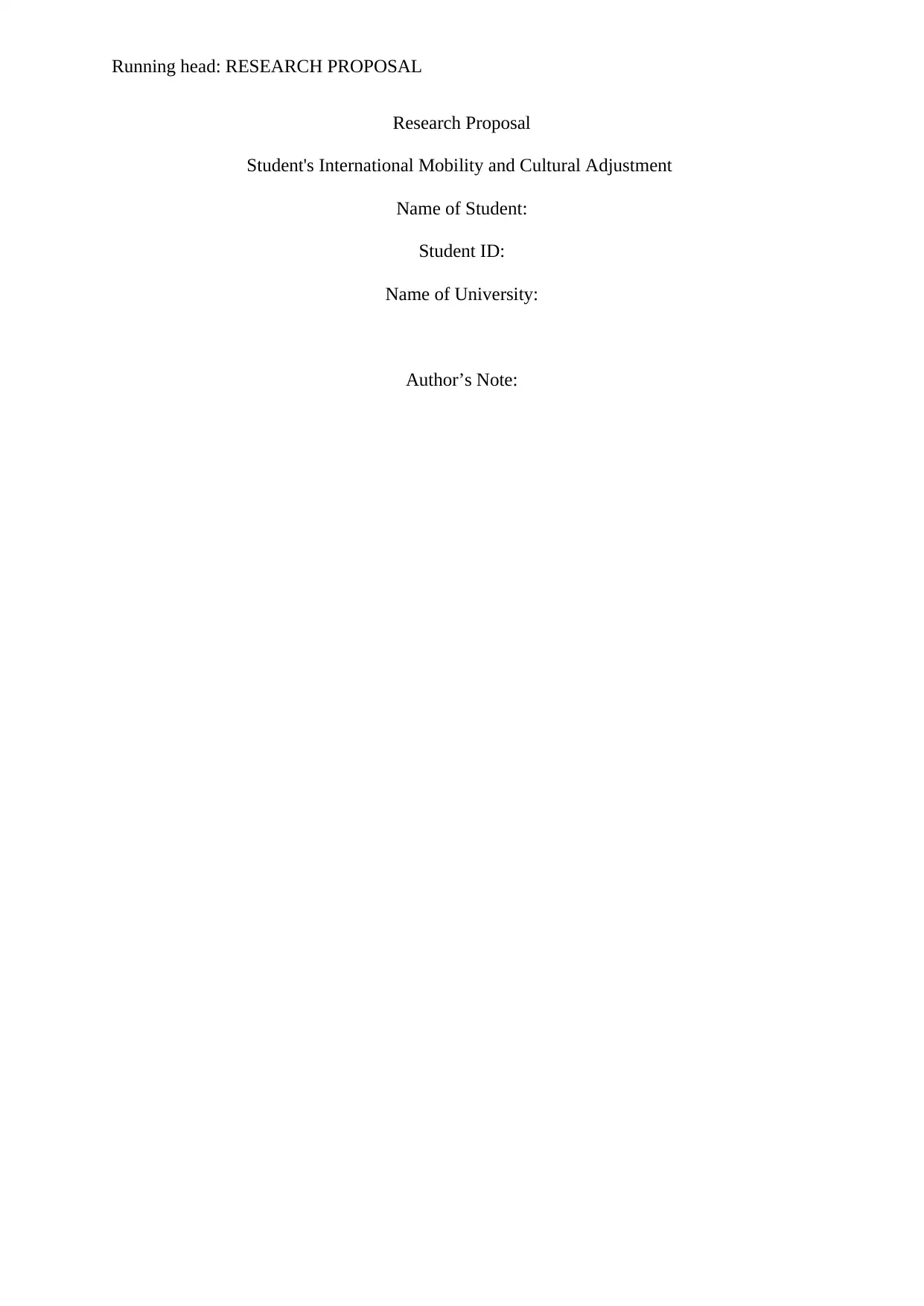
Running head: RESEARCH PROPOSAL
Research Proposal
Student's International Mobility and Cultural Adjustment
Name of Student:
Student ID:
Name of University:
Author’s Note:
Research Proposal
Student's International Mobility and Cultural Adjustment
Name of Student:
Student ID:
Name of University:
Author’s Note:
Paraphrase This Document
Need a fresh take? Get an instant paraphrase of this document with our AI Paraphraser
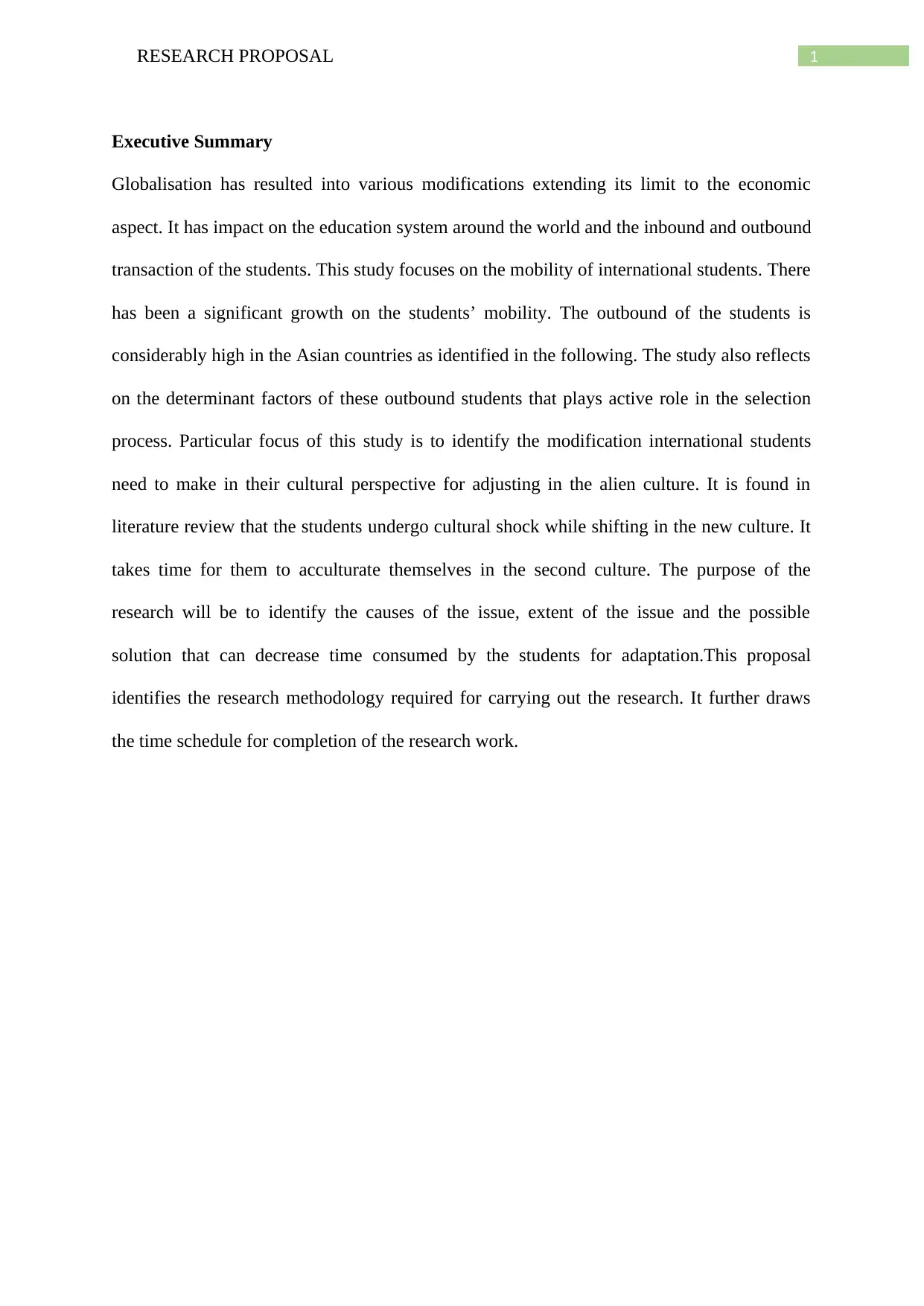
1RESEARCH PROPOSAL
Executive Summary
Globalisation has resulted into various modifications extending its limit to the economic
aspect. It has impact on the education system around the world and the inbound and outbound
transaction of the students. This study focuses on the mobility of international students. There
has been a significant growth on the students’ mobility. The outbound of the students is
considerably high in the Asian countries as identified in the following. The study also reflects
on the determinant factors of these outbound students that plays active role in the selection
process. Particular focus of this study is to identify the modification international students
need to make in their cultural perspective for adjusting in the alien culture. It is found in
literature review that the students undergo cultural shock while shifting in the new culture. It
takes time for them to acculturate themselves in the second culture. The purpose of the
research will be to identify the causes of the issue, extent of the issue and the possible
solution that can decrease time consumed by the students for adaptation.This proposal
identifies the research methodology required for carrying out the research. It further draws
the time schedule for completion of the research work.
Executive Summary
Globalisation has resulted into various modifications extending its limit to the economic
aspect. It has impact on the education system around the world and the inbound and outbound
transaction of the students. This study focuses on the mobility of international students. There
has been a significant growth on the students’ mobility. The outbound of the students is
considerably high in the Asian countries as identified in the following. The study also reflects
on the determinant factors of these outbound students that plays active role in the selection
process. Particular focus of this study is to identify the modification international students
need to make in their cultural perspective for adjusting in the alien culture. It is found in
literature review that the students undergo cultural shock while shifting in the new culture. It
takes time for them to acculturate themselves in the second culture. The purpose of the
research will be to identify the causes of the issue, extent of the issue and the possible
solution that can decrease time consumed by the students for adaptation.This proposal
identifies the research methodology required for carrying out the research. It further draws
the time schedule for completion of the research work.
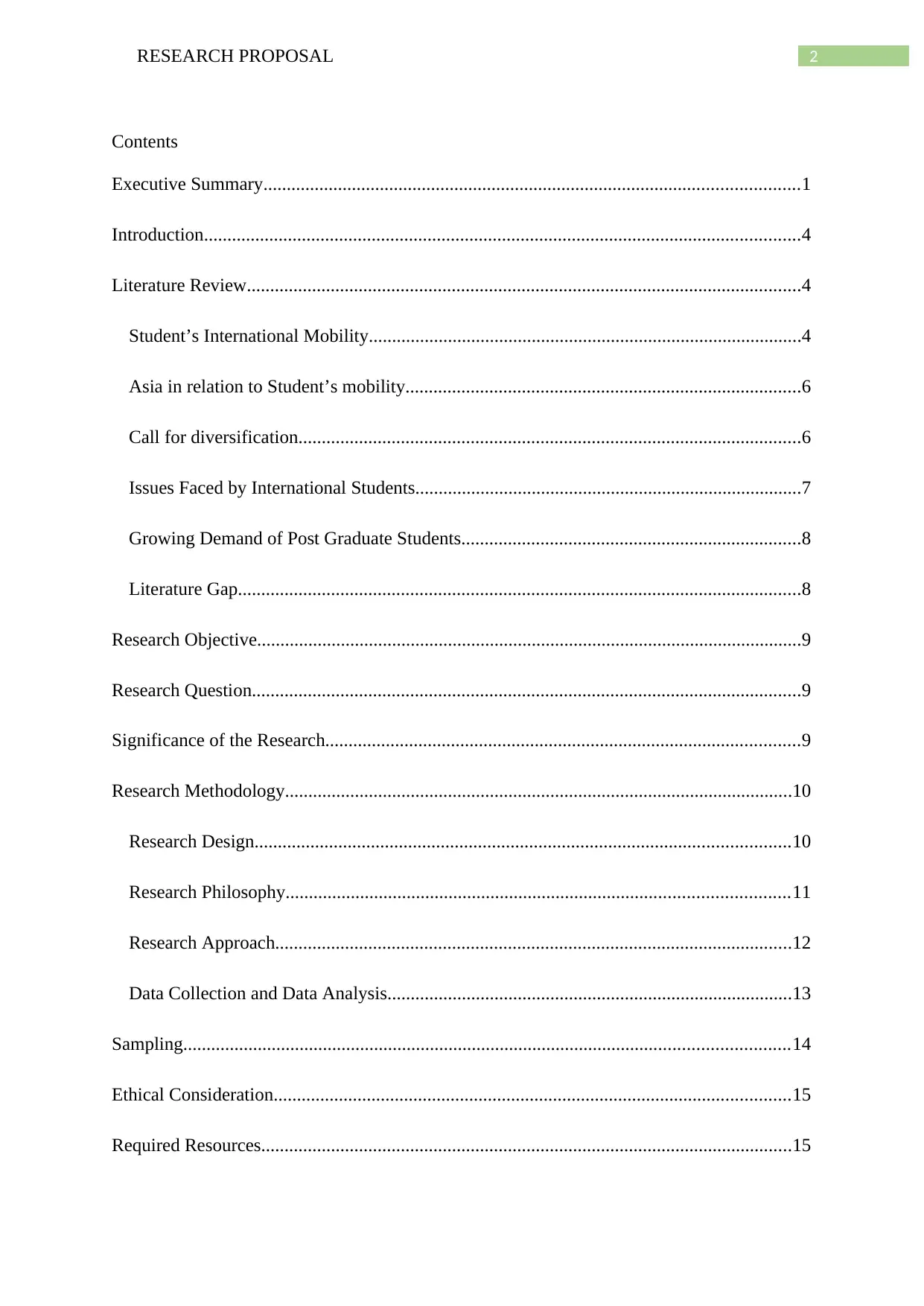
2RESEARCH PROPOSAL
Contents
Executive Summary...................................................................................................................1
Introduction................................................................................................................................4
Literature Review.......................................................................................................................4
Student’s International Mobility.............................................................................................4
Asia in relation to Student’s mobility.....................................................................................6
Call for diversification............................................................................................................6
Issues Faced by International Students...................................................................................7
Growing Demand of Post Graduate Students.........................................................................8
Literature Gap.........................................................................................................................8
Research Objective.....................................................................................................................9
Research Question......................................................................................................................9
Significance of the Research......................................................................................................9
Research Methodology.............................................................................................................10
Research Design...................................................................................................................10
Research Philosophy............................................................................................................11
Research Approach...............................................................................................................12
Data Collection and Data Analysis.......................................................................................13
Sampling..................................................................................................................................14
Ethical Consideration...............................................................................................................15
Required Resources..................................................................................................................15
Contents
Executive Summary...................................................................................................................1
Introduction................................................................................................................................4
Literature Review.......................................................................................................................4
Student’s International Mobility.............................................................................................4
Asia in relation to Student’s mobility.....................................................................................6
Call for diversification............................................................................................................6
Issues Faced by International Students...................................................................................7
Growing Demand of Post Graduate Students.........................................................................8
Literature Gap.........................................................................................................................8
Research Objective.....................................................................................................................9
Research Question......................................................................................................................9
Significance of the Research......................................................................................................9
Research Methodology.............................................................................................................10
Research Design...................................................................................................................10
Research Philosophy............................................................................................................11
Research Approach...............................................................................................................12
Data Collection and Data Analysis.......................................................................................13
Sampling..................................................................................................................................14
Ethical Consideration...............................................................................................................15
Required Resources..................................................................................................................15
⊘ This is a preview!⊘
Do you want full access?
Subscribe today to unlock all pages.

Trusted by 1+ million students worldwide

3RESEARCH PROPOSAL
Anticipated Problems and Way Out.........................................................................................16
Time Scale................................................................................................................................16
Conclusion................................................................................................................................18
References................................................................................................................................19
Anticipated Problems and Way Out.........................................................................................16
Time Scale................................................................................................................................16
Conclusion................................................................................................................................18
References................................................................................................................................19
Paraphrase This Document
Need a fresh take? Get an instant paraphrase of this document with our AI Paraphraser
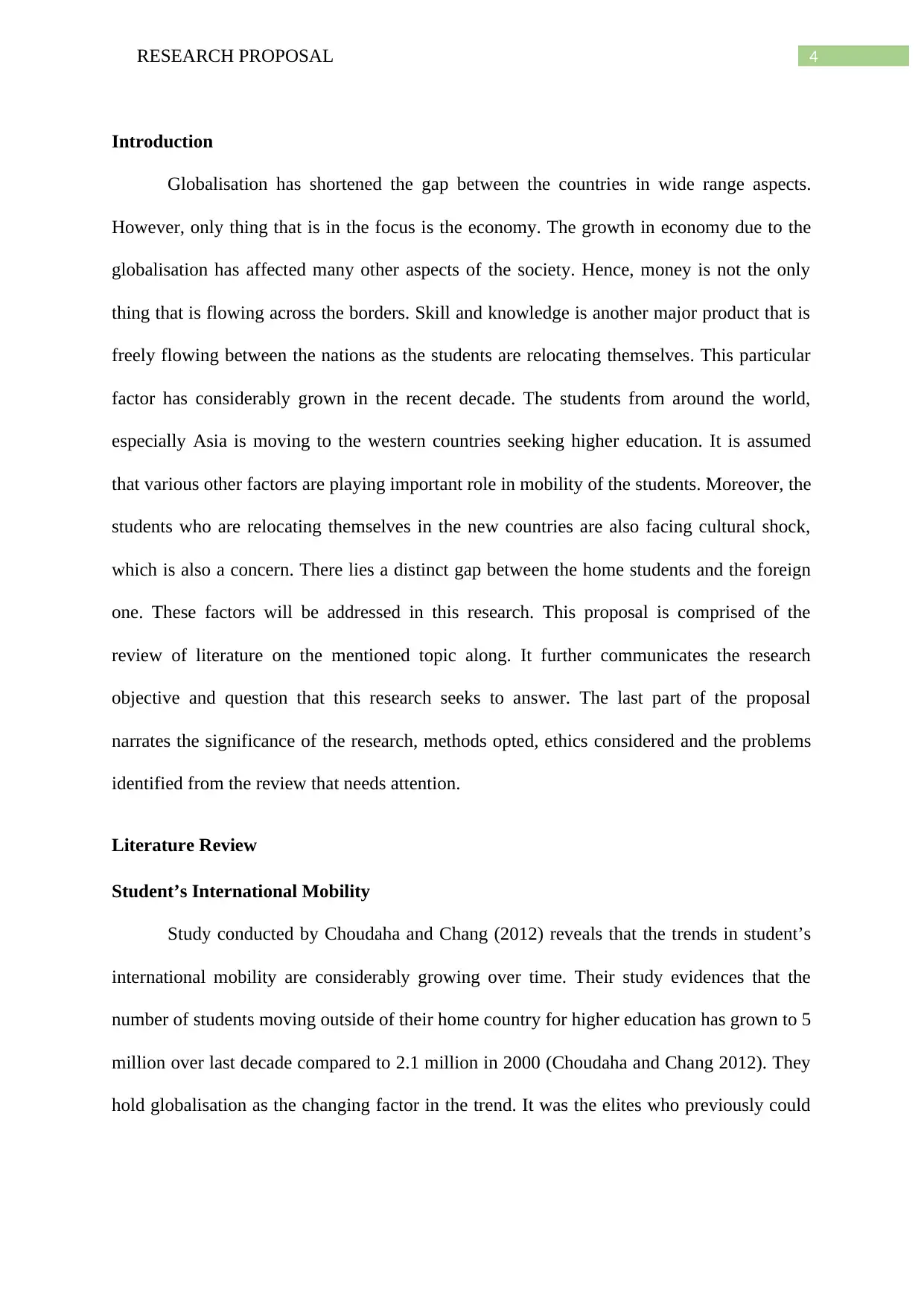
4RESEARCH PROPOSAL
Introduction
Globalisation has shortened the gap between the countries in wide range aspects.
However, only thing that is in the focus is the economy. The growth in economy due to the
globalisation has affected many other aspects of the society. Hence, money is not the only
thing that is flowing across the borders. Skill and knowledge is another major product that is
freely flowing between the nations as the students are relocating themselves. This particular
factor has considerably grown in the recent decade. The students from around the world,
especially Asia is moving to the western countries seeking higher education. It is assumed
that various other factors are playing important role in mobility of the students. Moreover, the
students who are relocating themselves in the new countries are also facing cultural shock,
which is also a concern. There lies a distinct gap between the home students and the foreign
one. These factors will be addressed in this research. This proposal is comprised of the
review of literature on the mentioned topic along. It further communicates the research
objective and question that this research seeks to answer. The last part of the proposal
narrates the significance of the research, methods opted, ethics considered and the problems
identified from the review that needs attention.
Literature Review
Student’s International Mobility
Study conducted by Choudaha and Chang (2012) reveals that the trends in student’s
international mobility are considerably growing over time. Their study evidences that the
number of students moving outside of their home country for higher education has grown to 5
million over last decade compared to 2.1 million in 2000 (Choudaha and Chang 2012). They
hold globalisation as the changing factor in the trend. It was the elites who previously could
Introduction
Globalisation has shortened the gap between the countries in wide range aspects.
However, only thing that is in the focus is the economy. The growth in economy due to the
globalisation has affected many other aspects of the society. Hence, money is not the only
thing that is flowing across the borders. Skill and knowledge is another major product that is
freely flowing between the nations as the students are relocating themselves. This particular
factor has considerably grown in the recent decade. The students from around the world,
especially Asia is moving to the western countries seeking higher education. It is assumed
that various other factors are playing important role in mobility of the students. Moreover, the
students who are relocating themselves in the new countries are also facing cultural shock,
which is also a concern. There lies a distinct gap between the home students and the foreign
one. These factors will be addressed in this research. This proposal is comprised of the
review of literature on the mentioned topic along. It further communicates the research
objective and question that this research seeks to answer. The last part of the proposal
narrates the significance of the research, methods opted, ethics considered and the problems
identified from the review that needs attention.
Literature Review
Student’s International Mobility
Study conducted by Choudaha and Chang (2012) reveals that the trends in student’s
international mobility are considerably growing over time. Their study evidences that the
number of students moving outside of their home country for higher education has grown to 5
million over last decade compared to 2.1 million in 2000 (Choudaha and Chang 2012). They
hold globalisation as the changing factor in the trend. It was the elites who previously could
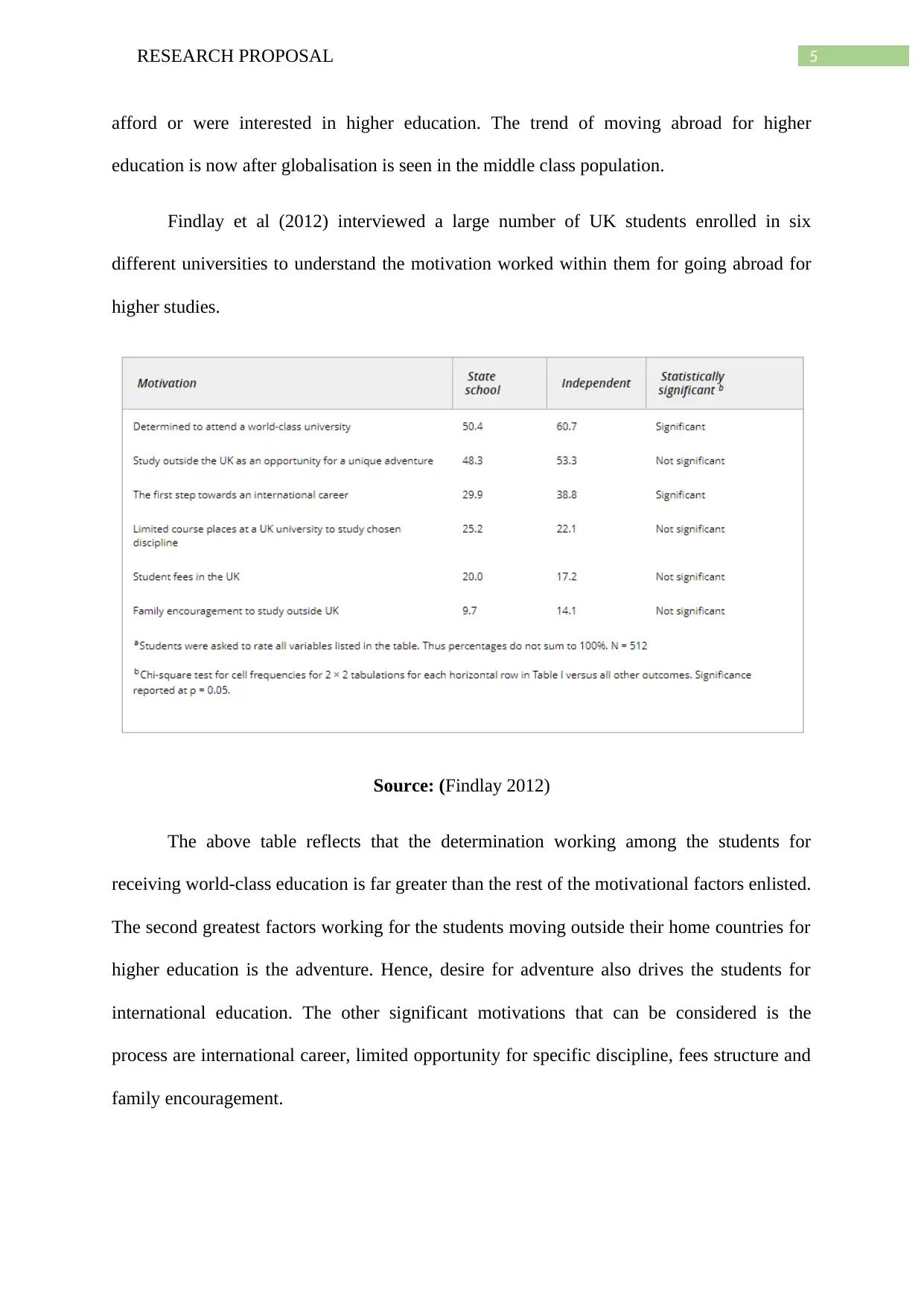
5RESEARCH PROPOSAL
afford or were interested in higher education. The trend of moving abroad for higher
education is now after globalisation is seen in the middle class population.
Findlay et al (2012) interviewed a large number of UK students enrolled in six
different universities to understand the motivation worked within them for going abroad for
higher studies.
Source: (Findlay 2012)
The above table reflects that the determination working among the students for
receiving world-class education is far greater than the rest of the motivational factors enlisted.
The second greatest factors working for the students moving outside their home countries for
higher education is the adventure. Hence, desire for adventure also drives the students for
international education. The other significant motivations that can be considered is the
process are international career, limited opportunity for specific discipline, fees structure and
family encouragement.
afford or were interested in higher education. The trend of moving abroad for higher
education is now after globalisation is seen in the middle class population.
Findlay et al (2012) interviewed a large number of UK students enrolled in six
different universities to understand the motivation worked within them for going abroad for
higher studies.
Source: (Findlay 2012)
The above table reflects that the determination working among the students for
receiving world-class education is far greater than the rest of the motivational factors enlisted.
The second greatest factors working for the students moving outside their home countries for
higher education is the adventure. Hence, desire for adventure also drives the students for
international education. The other significant motivations that can be considered is the
process are international career, limited opportunity for specific discipline, fees structure and
family encouragement.
⊘ This is a preview!⊘
Do you want full access?
Subscribe today to unlock all pages.

Trusted by 1+ million students worldwide
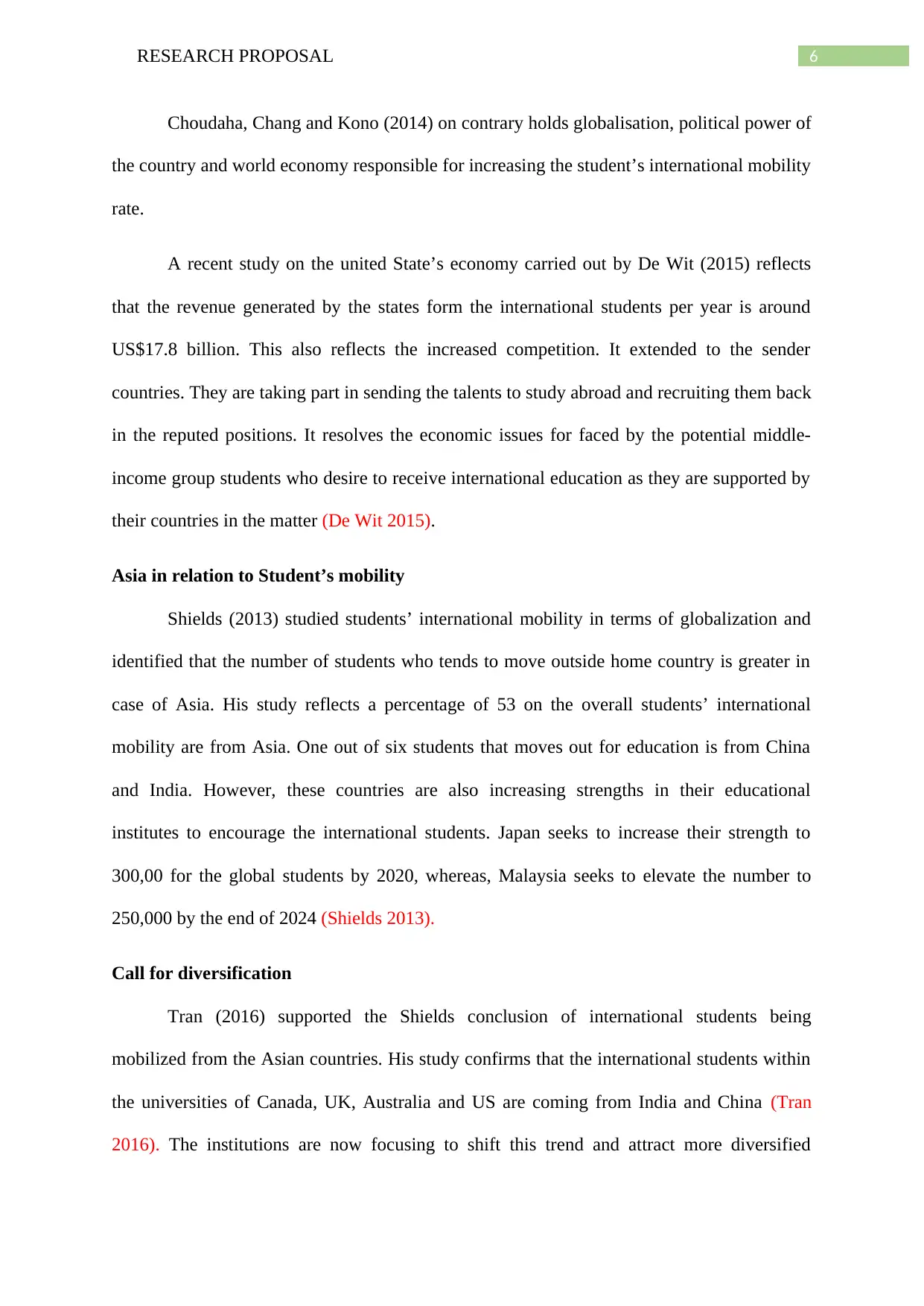
6RESEARCH PROPOSAL
Choudaha, Chang and Kono (2014) on contrary holds globalisation, political power of
the country and world economy responsible for increasing the student’s international mobility
rate.
A recent study on the united State’s economy carried out by De Wit (2015) reflects
that the revenue generated by the states form the international students per year is around
US$17.8 billion. This also reflects the increased competition. It extended to the sender
countries. They are taking part in sending the talents to study abroad and recruiting them back
in the reputed positions. It resolves the economic issues for faced by the potential middle-
income group students who desire to receive international education as they are supported by
their countries in the matter (De Wit 2015).
Asia in relation to Student’s mobility
Shields (2013) studied students’ international mobility in terms of globalization and
identified that the number of students who tends to move outside home country is greater in
case of Asia. His study reflects a percentage of 53 on the overall students’ international
mobility are from Asia. One out of six students that moves out for education is from China
and India. However, these countries are also increasing strengths in their educational
institutes to encourage the international students. Japan seeks to increase their strength to
300,00 for the global students by 2020, whereas, Malaysia seeks to elevate the number to
250,000 by the end of 2024 (Shields 2013).
Call for diversification
Tran (2016) supported the Shields conclusion of international students being
mobilized from the Asian countries. His study confirms that the international students within
the universities of Canada, UK, Australia and US are coming from India and China (Tran
2016). The institutions are now focusing to shift this trend and attract more diversified
Choudaha, Chang and Kono (2014) on contrary holds globalisation, political power of
the country and world economy responsible for increasing the student’s international mobility
rate.
A recent study on the united State’s economy carried out by De Wit (2015) reflects
that the revenue generated by the states form the international students per year is around
US$17.8 billion. This also reflects the increased competition. It extended to the sender
countries. They are taking part in sending the talents to study abroad and recruiting them back
in the reputed positions. It resolves the economic issues for faced by the potential middle-
income group students who desire to receive international education as they are supported by
their countries in the matter (De Wit 2015).
Asia in relation to Student’s mobility
Shields (2013) studied students’ international mobility in terms of globalization and
identified that the number of students who tends to move outside home country is greater in
case of Asia. His study reflects a percentage of 53 on the overall students’ international
mobility are from Asia. One out of six students that moves out for education is from China
and India. However, these countries are also increasing strengths in their educational
institutes to encourage the international students. Japan seeks to increase their strength to
300,00 for the global students by 2020, whereas, Malaysia seeks to elevate the number to
250,000 by the end of 2024 (Shields 2013).
Call for diversification
Tran (2016) supported the Shields conclusion of international students being
mobilized from the Asian countries. His study confirms that the international students within
the universities of Canada, UK, Australia and US are coming from India and China (Tran
2016). The institutions are now focusing to shift this trend and attract more diversified
Paraphrase This Document
Need a fresh take? Get an instant paraphrase of this document with our AI Paraphraser
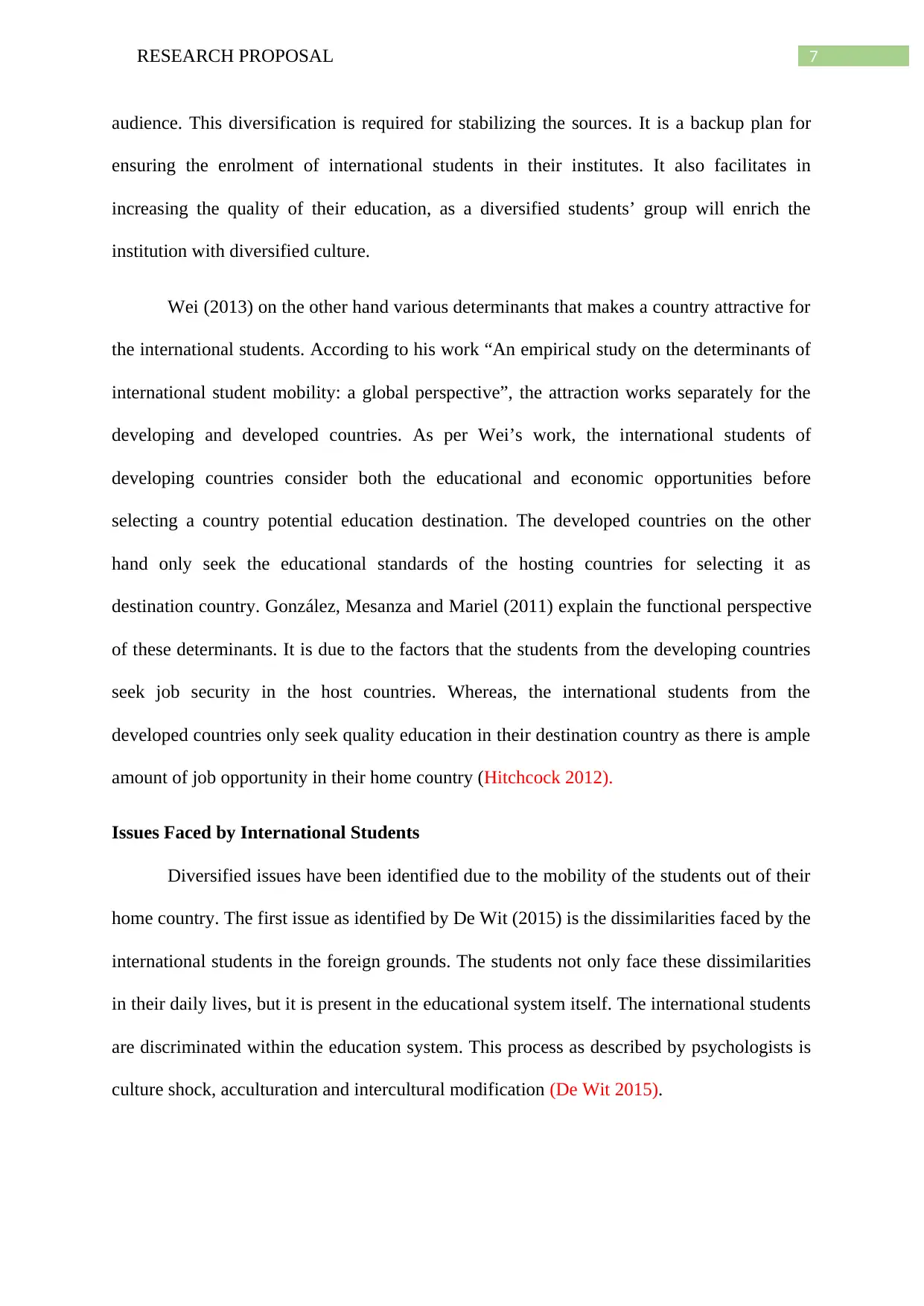
7RESEARCH PROPOSAL
audience. This diversification is required for stabilizing the sources. It is a backup plan for
ensuring the enrolment of international students in their institutes. It also facilitates in
increasing the quality of their education, as a diversified students’ group will enrich the
institution with diversified culture.
Wei (2013) on the other hand various determinants that makes a country attractive for
the international students. According to his work “An empirical study on the determinants of
international student mobility: a global perspective”, the attraction works separately for the
developing and developed countries. As per Wei’s work, the international students of
developing countries consider both the educational and economic opportunities before
selecting a country potential education destination. The developed countries on the other
hand only seek the educational standards of the hosting countries for selecting it as
destination country. González, Mesanza and Mariel (2011) explain the functional perspective
of these determinants. It is due to the factors that the students from the developing countries
seek job security in the host countries. Whereas, the international students from the
developed countries only seek quality education in their destination country as there is ample
amount of job opportunity in their home country (Hitchcock 2012).
Issues Faced by International Students
Diversified issues have been identified due to the mobility of the students out of their
home country. The first issue as identified by De Wit (2015) is the dissimilarities faced by the
international students in the foreign grounds. The students not only face these dissimilarities
in their daily lives, but it is present in the educational system itself. The international students
are discriminated within the education system. This process as described by psychologists is
culture shock, acculturation and intercultural modification (De Wit 2015).
audience. This diversification is required for stabilizing the sources. It is a backup plan for
ensuring the enrolment of international students in their institutes. It also facilitates in
increasing the quality of their education, as a diversified students’ group will enrich the
institution with diversified culture.
Wei (2013) on the other hand various determinants that makes a country attractive for
the international students. According to his work “An empirical study on the determinants of
international student mobility: a global perspective”, the attraction works separately for the
developing and developed countries. As per Wei’s work, the international students of
developing countries consider both the educational and economic opportunities before
selecting a country potential education destination. The developed countries on the other
hand only seek the educational standards of the hosting countries for selecting it as
destination country. González, Mesanza and Mariel (2011) explain the functional perspective
of these determinants. It is due to the factors that the students from the developing countries
seek job security in the host countries. Whereas, the international students from the
developed countries only seek quality education in their destination country as there is ample
amount of job opportunity in their home country (Hitchcock 2012).
Issues Faced by International Students
Diversified issues have been identified due to the mobility of the students out of their
home country. The first issue as identified by De Wit (2015) is the dissimilarities faced by the
international students in the foreign grounds. The students not only face these dissimilarities
in their daily lives, but it is present in the educational system itself. The international students
are discriminated within the education system. This process as described by psychologists is
culture shock, acculturation and intercultural modification (De Wit 2015).
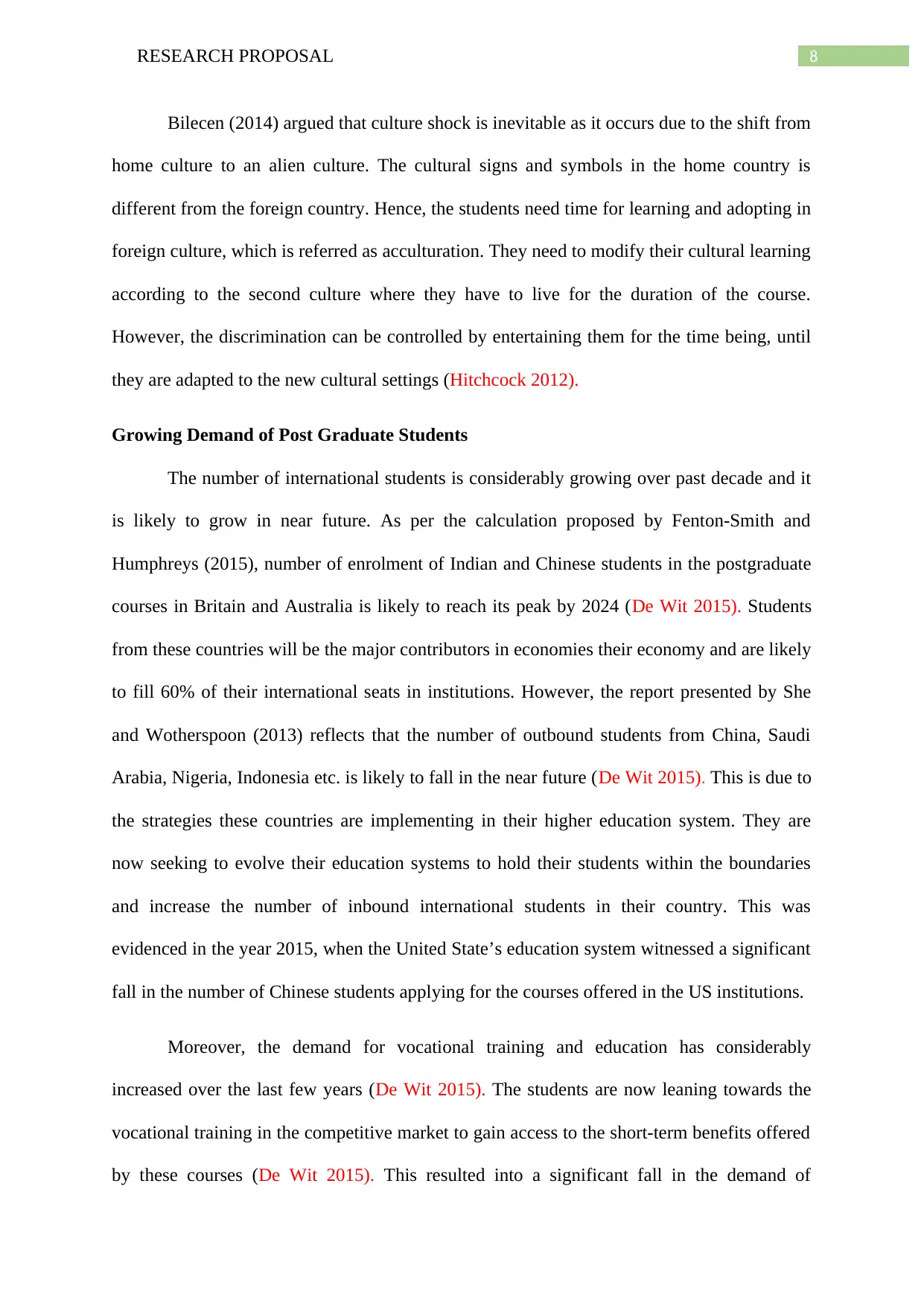
8RESEARCH PROPOSAL
Bilecen (2014) argued that culture shock is inevitable as it occurs due to the shift from
home culture to an alien culture. The cultural signs and symbols in the home country is
different from the foreign country. Hence, the students need time for learning and adopting in
foreign culture, which is referred as acculturation. They need to modify their cultural learning
according to the second culture where they have to live for the duration of the course.
However, the discrimination can be controlled by entertaining them for the time being, until
they are adapted to the new cultural settings (Hitchcock 2012).
Growing Demand of Post Graduate Students
The number of international students is considerably growing over past decade and it
is likely to grow in near future. As per the calculation proposed by Fenton-Smith and
Humphreys (2015), number of enrolment of Indian and Chinese students in the postgraduate
courses in Britain and Australia is likely to reach its peak by 2024 (De Wit 2015). Students
from these countries will be the major contributors in economies their economy and are likely
to fill 60% of their international seats in institutions. However, the report presented by She
and Wotherspoon (2013) reflects that the number of outbound students from China, Saudi
Arabia, Nigeria, Indonesia etc. is likely to fall in the near future (De Wit 2015). This is due to
the strategies these countries are implementing in their higher education system. They are
now seeking to evolve their education systems to hold their students within the boundaries
and increase the number of inbound international students in their country. This was
evidenced in the year 2015, when the United State’s education system witnessed a significant
fall in the number of Chinese students applying for the courses offered in the US institutions.
Moreover, the demand for vocational training and education has considerably
increased over the last few years (De Wit 2015). The students are now leaning towards the
vocational training in the competitive market to gain access to the short-term benefits offered
by these courses (De Wit 2015). This resulted into a significant fall in the demand of
Bilecen (2014) argued that culture shock is inevitable as it occurs due to the shift from
home culture to an alien culture. The cultural signs and symbols in the home country is
different from the foreign country. Hence, the students need time for learning and adopting in
foreign culture, which is referred as acculturation. They need to modify their cultural learning
according to the second culture where they have to live for the duration of the course.
However, the discrimination can be controlled by entertaining them for the time being, until
they are adapted to the new cultural settings (Hitchcock 2012).
Growing Demand of Post Graduate Students
The number of international students is considerably growing over past decade and it
is likely to grow in near future. As per the calculation proposed by Fenton-Smith and
Humphreys (2015), number of enrolment of Indian and Chinese students in the postgraduate
courses in Britain and Australia is likely to reach its peak by 2024 (De Wit 2015). Students
from these countries will be the major contributors in economies their economy and are likely
to fill 60% of their international seats in institutions. However, the report presented by She
and Wotherspoon (2013) reflects that the number of outbound students from China, Saudi
Arabia, Nigeria, Indonesia etc. is likely to fall in the near future (De Wit 2015). This is due to
the strategies these countries are implementing in their higher education system. They are
now seeking to evolve their education systems to hold their students within the boundaries
and increase the number of inbound international students in their country. This was
evidenced in the year 2015, when the United State’s education system witnessed a significant
fall in the number of Chinese students applying for the courses offered in the US institutions.
Moreover, the demand for vocational training and education has considerably
increased over the last few years (De Wit 2015). The students are now leaning towards the
vocational training in the competitive market to gain access to the short-term benefits offered
by these courses (De Wit 2015). This resulted into a significant fall in the demand of
⊘ This is a preview!⊘
Do you want full access?
Subscribe today to unlock all pages.

Trusted by 1+ million students worldwide
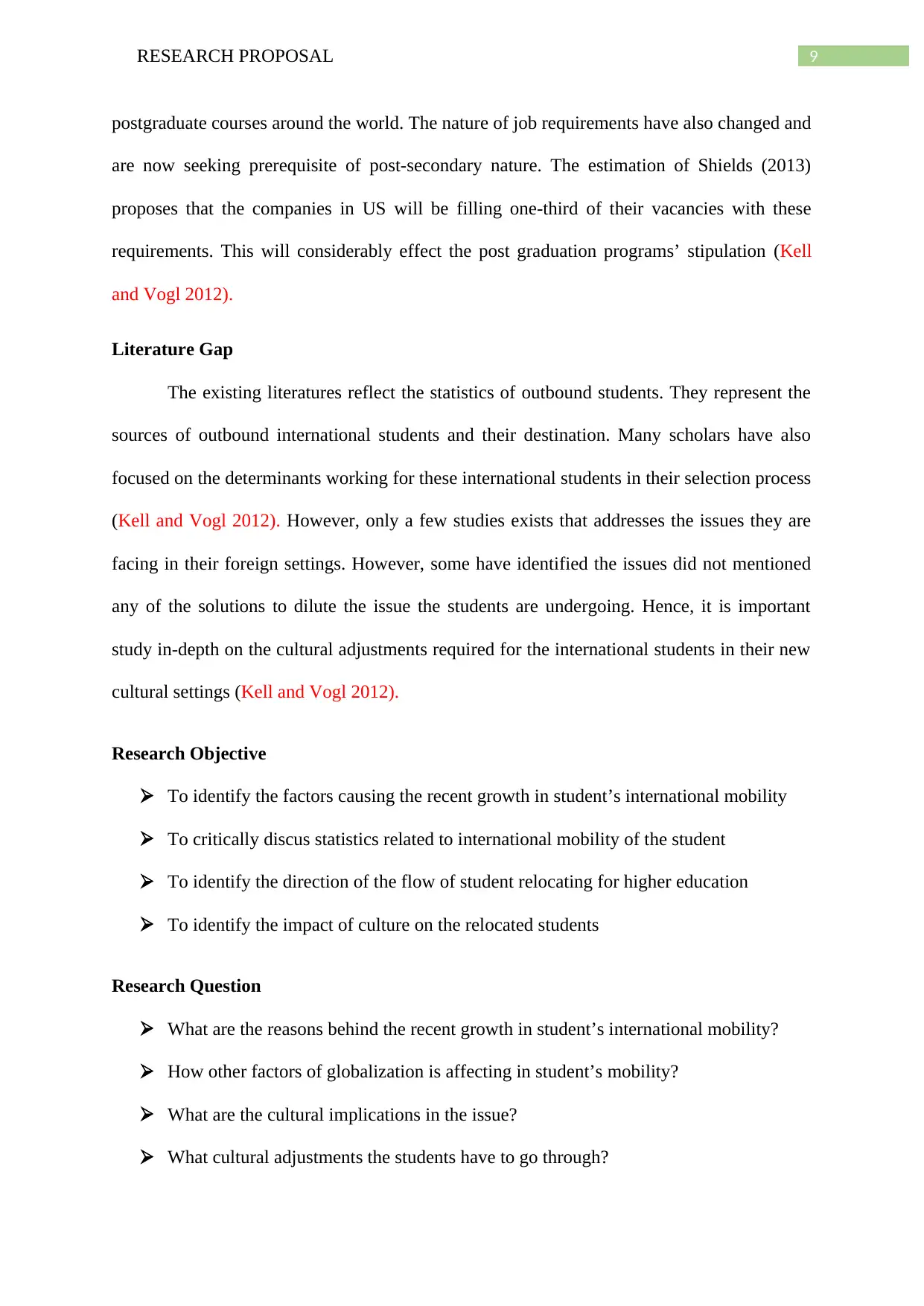
9RESEARCH PROPOSAL
postgraduate courses around the world. The nature of job requirements have also changed and
are now seeking prerequisite of post-secondary nature. The estimation of Shields (2013)
proposes that the companies in US will be filling one-third of their vacancies with these
requirements. This will considerably effect the post graduation programs’ stipulation (Kell
and Vogl 2012).
Literature Gap
The existing literatures reflect the statistics of outbound students. They represent the
sources of outbound international students and their destination. Many scholars have also
focused on the determinants working for these international students in their selection process
(Kell and Vogl 2012). However, only a few studies exists that addresses the issues they are
facing in their foreign settings. However, some have identified the issues did not mentioned
any of the solutions to dilute the issue the students are undergoing. Hence, it is important
study in-depth on the cultural adjustments required for the international students in their new
cultural settings (Kell and Vogl 2012).
Research Objective
To identify the factors causing the recent growth in student’s international mobility
To critically discus statistics related to international mobility of the student
To identify the direction of the flow of student relocating for higher education
To identify the impact of culture on the relocated students
Research Question
What are the reasons behind the recent growth in student’s international mobility?
How other factors of globalization is affecting in student’s mobility?
What are the cultural implications in the issue?
What cultural adjustments the students have to go through?
postgraduate courses around the world. The nature of job requirements have also changed and
are now seeking prerequisite of post-secondary nature. The estimation of Shields (2013)
proposes that the companies in US will be filling one-third of their vacancies with these
requirements. This will considerably effect the post graduation programs’ stipulation (Kell
and Vogl 2012).
Literature Gap
The existing literatures reflect the statistics of outbound students. They represent the
sources of outbound international students and their destination. Many scholars have also
focused on the determinants working for these international students in their selection process
(Kell and Vogl 2012). However, only a few studies exists that addresses the issues they are
facing in their foreign settings. However, some have identified the issues did not mentioned
any of the solutions to dilute the issue the students are undergoing. Hence, it is important
study in-depth on the cultural adjustments required for the international students in their new
cultural settings (Kell and Vogl 2012).
Research Objective
To identify the factors causing the recent growth in student’s international mobility
To critically discus statistics related to international mobility of the student
To identify the direction of the flow of student relocating for higher education
To identify the impact of culture on the relocated students
Research Question
What are the reasons behind the recent growth in student’s international mobility?
How other factors of globalization is affecting in student’s mobility?
What are the cultural implications in the issue?
What cultural adjustments the students have to go through?
Paraphrase This Document
Need a fresh take? Get an instant paraphrase of this document with our AI Paraphraser
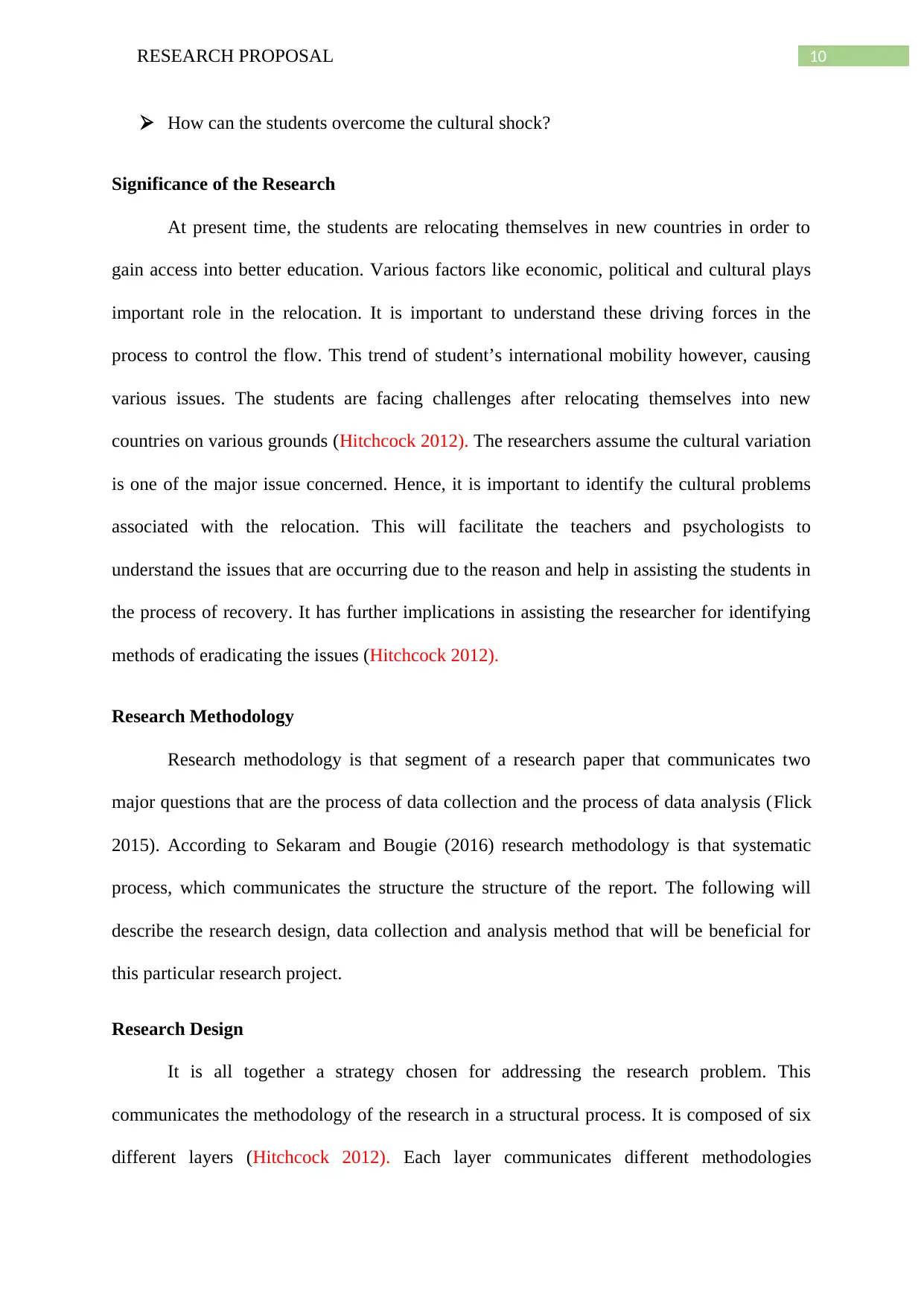
10RESEARCH PROPOSAL
How can the students overcome the cultural shock?
Significance of the Research
At present time, the students are relocating themselves in new countries in order to
gain access into better education. Various factors like economic, political and cultural plays
important role in the relocation. It is important to understand these driving forces in the
process to control the flow. This trend of student’s international mobility however, causing
various issues. The students are facing challenges after relocating themselves into new
countries on various grounds (Hitchcock 2012). The researchers assume the cultural variation
is one of the major issue concerned. Hence, it is important to identify the cultural problems
associated with the relocation. This will facilitate the teachers and psychologists to
understand the issues that are occurring due to the reason and help in assisting the students in
the process of recovery. It has further implications in assisting the researcher for identifying
methods of eradicating the issues (Hitchcock 2012).
Research Methodology
Research methodology is that segment of a research paper that communicates two
major questions that are the process of data collection and the process of data analysis (Flick
2015). According to Sekaram and Bougie (2016) research methodology is that systematic
process, which communicates the structure the structure of the report. The following will
describe the research design, data collection and analysis method that will be beneficial for
this particular research project.
Research Design
It is all together a strategy chosen for addressing the research problem. This
communicates the methodology of the research in a structural process. It is composed of six
different layers (Hitchcock 2012). Each layer communicates different methodologies
How can the students overcome the cultural shock?
Significance of the Research
At present time, the students are relocating themselves in new countries in order to
gain access into better education. Various factors like economic, political and cultural plays
important role in the relocation. It is important to understand these driving forces in the
process to control the flow. This trend of student’s international mobility however, causing
various issues. The students are facing challenges after relocating themselves into new
countries on various grounds (Hitchcock 2012). The researchers assume the cultural variation
is one of the major issue concerned. Hence, it is important to identify the cultural problems
associated with the relocation. This will facilitate the teachers and psychologists to
understand the issues that are occurring due to the reason and help in assisting the students in
the process of recovery. It has further implications in assisting the researcher for identifying
methods of eradicating the issues (Hitchcock 2012).
Research Methodology
Research methodology is that segment of a research paper that communicates two
major questions that are the process of data collection and the process of data analysis (Flick
2015). According to Sekaram and Bougie (2016) research methodology is that systematic
process, which communicates the structure the structure of the report. The following will
describe the research design, data collection and analysis method that will be beneficial for
this particular research project.
Research Design
It is all together a strategy chosen for addressing the research problem. This
communicates the methodology of the research in a structural process. It is composed of six
different layers (Hitchcock 2012). Each layer communicates different methodologies
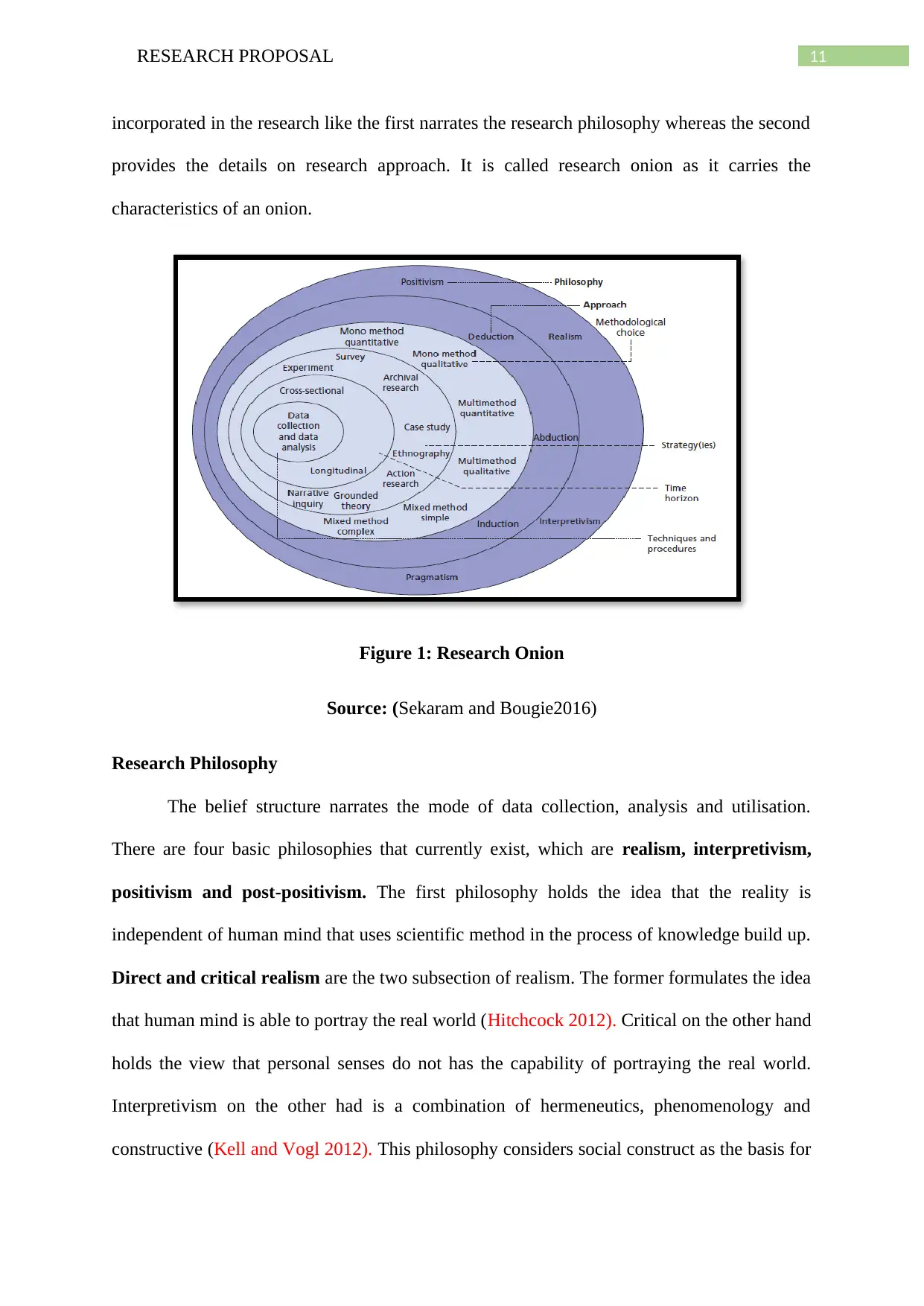
11RESEARCH PROPOSAL
incorporated in the research like the first narrates the research philosophy whereas the second
provides the details on research approach. It is called research onion as it carries the
characteristics of an onion.
Figure 1: Research Onion
Source: (Sekaram and Bougie2016)
Research Philosophy
The belief structure narrates the mode of data collection, analysis and utilisation.
There are four basic philosophies that currently exist, which are realism, interpretivism,
positivism and post-positivism. The first philosophy holds the idea that the reality is
independent of human mind that uses scientific method in the process of knowledge build up.
Direct and critical realism are the two subsection of realism. The former formulates the idea
that human mind is able to portray the real world (Hitchcock 2012). Critical on the other hand
holds the view that personal senses do not has the capability of portraying the real world.
Interpretivism on the other had is a combination of hermeneutics, phenomenology and
constructive (Kell and Vogl 2012). This philosophy considers social construct as the basis for
incorporated in the research like the first narrates the research philosophy whereas the second
provides the details on research approach. It is called research onion as it carries the
characteristics of an onion.
Figure 1: Research Onion
Source: (Sekaram and Bougie2016)
Research Philosophy
The belief structure narrates the mode of data collection, analysis and utilisation.
There are four basic philosophies that currently exist, which are realism, interpretivism,
positivism and post-positivism. The first philosophy holds the idea that the reality is
independent of human mind that uses scientific method in the process of knowledge build up.
Direct and critical realism are the two subsection of realism. The former formulates the idea
that human mind is able to portray the real world (Hitchcock 2012). Critical on the other hand
holds the view that personal senses do not has the capability of portraying the real world.
Interpretivism on the other had is a combination of hermeneutics, phenomenology and
constructive (Kell and Vogl 2012). This philosophy considers social construct as the basis for
⊘ This is a preview!⊘
Do you want full access?
Subscribe today to unlock all pages.

Trusted by 1+ million students worldwide
1 out of 23
Related Documents
Your All-in-One AI-Powered Toolkit for Academic Success.
+13062052269
info@desklib.com
Available 24*7 on WhatsApp / Email
![[object Object]](/_next/static/media/star-bottom.7253800d.svg)
Unlock your academic potential
Copyright © 2020–2025 A2Z Services. All Rights Reserved. Developed and managed by ZUCOL.



